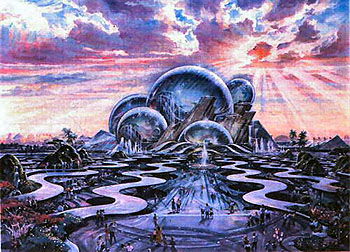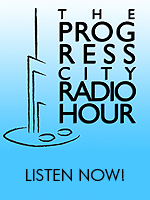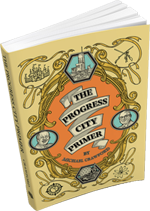At the start of the 1990s Eisner had grand plans. He announced the Disney Decade, which would result in four fully-realized Disney resorts around the world. No longer would Disneyland exist only as a single theme park; rather, it would soon be the centerpiece of an entire destination resort along the lines of Walt Disney World in Florida. Eisner was obsessed in locking families in to an entire Disney vacation; at no point should they have to leave property to spend their carefully earned cash. California would soon see a new Disney park – the only question was where.
 Oceana, the central visual icon of Port Disney’s DisneySea park
Oceana, the central visual icon of Port Disney’s DisneySea parkIn the first act of defiant arrogance that would presage the ultimate failure of the Disney Decade, Eisner decided to play the cities of Anaheim and Long Beach against each other to determine where Disney would build its new park. Dangling the possibility of building one, both, or none of the parks, Eisner started a bidding war for which city could offer the best sweetheart deal while eliminating civic and governmental roadblocks in the shortest time.
The first volley came in July of 1990 when Disney announced plans for the Port Disney facility in Long Beach. This $2.8 billion, 414 acre seaside resort would be centered around the DisneySea park and also feature five resort hotels, retail shops and waterfront dining, a marina, and a port for cruise ships. The complex would incorporate the Queen Mary luxury liner, which along with Howard Hughes’ Spruce Goose had been obtained by Disney as part of their purchase of the Disneyland Hotel from the Wrather Corporation in 1989.
While Disney tried to overcome zoning and environmental hurdles in Long Beach, they continued to lay the groundwork for the Anaheim resort. In February of 1991 they acquired 23 acres of land – a former trailer park – adjacent to the Fujishige farm for $1.3 million an acre. At the same time, they offered the Fujishiges $32 million for a 99-year lease to their strawberry field. Fujishige declined, but did not rule out future negotiations despite calling Disney’s offer “insulting.” He told the Associated Press that “it sure seemed to me that I was about to end up like those Indians who used to own Manhattan Island. When they came in with such a low offer, I was about ready to walk out of the meeting right then. Disney will do what they want to do, and I’ll do what I want to do.”
 Spacestation Earth, the centerpiece of Westcot Center
Spacestation Earth, the centerpiece of Westcot CenterThings remained contentious throughout 1991. In May of that year, Disney revealed its new concept for Anaheim. An ambitious plan, it called for a $3 billion 470-acre resort expansion that would add three new hotels, a nighttime entertainment district, and Westcot Center – a new theme park that sought to perfect many of the concepts that Disney first tried at EPCOT Center in Florida.
It was a glorious plan, tying all the disparate pieces of the Disneyland Resort into a whole. All those small parcels of land occupied by abandoned motels and cheesy tourist traps that Disney had picked off over the years would be transformed into a lush resort with hotels, entertainment, and parks linked by monorail. The master plan even showed a large parcel of land to the southeast of the resort for future expansion – enough for a third theme park!
 Map of the Disneyland Resort expansion plans – the third park site is in the topmost corner of the diamond
Map of the Disneyland Resort expansion plans – the third park site is in the topmost corner of the diamondOne problem – Disney’s promotional materials for the master plan all labeled the Fujishige farm as the site of future expansion despite the fact that there was not, and had never been, any agreement for the family to sell their land to Disney. As part of the planning process for the resort, Disney included applications for permits to build a third park on the site. This did not go over well with the Fujishiges, who famously pronounced in 1993 that they would never, under any circumstances, sell their land to Disney.
So, here we are in 1991. Disney Imagineers, at the behest of Michael Eisner, have created plans for two theme parks that, if built, would be the jewels in Disney’s crown. Magnificent and highly integrated plans for resort areas had been created for the two cities, including plans for a third park in Anaheim. So what happened? And how, out of all this promise, do we wind up with the flaming bag of ordure that is California Adventure?








[…] themes. We’ve already touched upon the story of Disney’s America, as well as the process that led WESTCOT to be downsized and eventually cancelled. Port Disney followed a similar path to […]
Fascinating article, its really a shame what the management did to Disneyland and Disney World in the ’90s, even today.
As of right now it seems the third gate is going to be a parking lot until at least 2017-2018. We can keep our fingers crossed for what it will become after that but they have lots of issues to fix in their existing parks before building a third or fifth gate.
Thanks… it’s true, we’re still paying the price for those policies.
I’ve been so busy lately I haven’t had a chance to cover the parking lot news. Looks like Third Theme Park is a ways away, and that’s probably a good thing. DCA is no Westcot, and needs many years of attention. Disneyland, too, needs some love and a new Tomorrowland!
Another fantastic article. I am constantly captivated by the wonderful information you present and much appreciate (and in most instances agree) with your commentary about the state of Disney theme parks, its successes, failures, and changes that need to be made.
I hate to take the discussion into the realm of backseat imagineering, but I hope the powers at be, as penance for DCA, really work to conceive a wholly original and inspired third gate for DLR. I cannot help but have a kernel of hope for DCA given the flavor of improvements they are applying to the park, specifically Buena Vista Street and the (albeit superficial) re-themed Silly Symphony Swings. DCA could be very successful as “Walt Disney’s California Adventure,” a park dedicated to the California young Walt experienced, the one that inspired and informed his work, and what came of it in his early years. I think this sort of philosophy, a sort of back-to-the-beginning investigation of Disney history and appreciation for classics, should really be at the heart of Disneyland development. Let Disney World be innovative. Let DLR be that little bit of the past Walt hoped no one would ever truly let go of.
In that vein, I wouldn’t want to see a revival of Disney’s America or Port Disney. I wouldn’t even want to see WestCOT, as impressive as the concept was, just because it draws so heavily from Epcot (and I’m sure we will never see the concept of a city ever again). DCA’s Hollywoodland has, thankfully, saved us from another studios park, and the plot of land couldn’t accommodate something akin to Animal Kingdom. As I child, when I first saw the Silly Symphony short “Music Land,” I thought that would be an amazing theme for a park, with Disney shorts and Silly Symphonies as the themes for lands and attractions, though I am unsure now if an entire park could be built with that theme. Nonetheless, this is the sort of development Disneyland deserves, and I hope management realizes this, too.